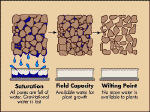
5.1 Soil Water Holding Capacity
One of the main functions of soil is to store
moisture and supply it to plants between rainfalls or irrigations.
Evaporation from the soil surface, transpiration by plants and deep
percolation combine to reduce soil moisture status between water
applications. If the water content becomes too low, plants become
stressed. The plant available moisture storage capacity of a soil provides
a buffer which determines a plantís capacity to withstand dry spells.
Forms of Soil Water Storage
Water is held in soil in various ways and not all of
it is available to plants.
Chemical
water is an integral part of the molecular structure of soil
minerals. It can be held tightly by electrostatic forces to the surfaces
of clay crystals and other minerals and is unavailable to plants.
The
rest of the water in the soil is held in pores, the spaces between the
soil particles. The amount of moisture that a soil can store and the
amount it can supply to plants are dependent on the number and size of its
pore spaces
|
Figure 1:
Ideal proportions of soil pores, their size,
function and formation

Click for larger picture
|
Gravitational
water is held in large soil pores and rapidly drains out under
the action of gravity within a day or so after rain. Plants can only make
use of gravitational water for a few days after rain.
Capillary
water is
held in pores that are small enough to hold water against gravity, but not
so tightly that roots cannot absorb it. This water occurs as a film around
soil particles and in the pores between them and is the main source of
plant moisture. As this water is withdrawn, the larger pores drain first.
The finer the pores, the more resistant they are to removal of water. As
water is withdrawn, the film becomes thinner and harder to detach from the
soil particles. This capillary water can move in all directions in
response to suction and can move upwards through soil for up to two
metres, the particles and pores of the soil acting like a wick.
When soil
is saturated, all the pores are full of water, but after a day,
all gravitational water drains out, leaving the soil at field capacity.
Plants then draw water out of the capillary pores, readily at first and
then with greater difficulty, until no more can be withdrawn and the only
water left is in the micro-pores. The soil is then at wilting point and
without water additions, plants die.
|
Figure 2::
Stages of Water Holding.

Click for larger image.
Source: Dept
of Agriculture Bulletin 462, 1960
|
The
amount of water available to plants is therefore determined by the
capillary porosity and is calculated by the difference in moisture content
between field capacity and wilting point. This is the total available water
storage of the soil. The portion of the total available moisture store, which
can be extracted by plants without becoming stressed, is termed readily
available water. Irrigators must have knowledge of the readily available
moisture capacity so that water can be applied before plants have to
expend excessive energy to extract moisture.
The
amount of soil water available to plants is governed by the depth of soil
that roots can explore (the root zone) and the nature of the soil
material. Because the total and available moisture storage capacities are
linked to porosity, the particle sizes (texture) and the arrangement of
particles (structure) are the critical factors. Organic matter and
carbonate levels and stone content also affect moisture storage.
Poor
structure, low organic matter, low carbonate content and presence of
stones all reduce the moisture storage capacity of a given texture class.
Clays store large amounts of water, but because they
have high wilting points, they need significant rain to be able to supply
water to plants. On the other hand, sands have limited water storage
capacity, but because most of it is available, plants can make use of
light showers regardless of how dry they are before the shower. Plants
growing in sand generally have a more dense root system to enable them to
access water quickly before the sand dries out.
|
Figure 3:
Water holding
capacity (mm/cm depth of soil) of main texture groups. Figures are averages and vary with structure and organic matter
differences.
|
|
Texture
|
Field Capacity
|
Wilting point
|
Available water
|
|
Coarse sand
|
0.6
|
0.2
|
0.4
|
|
Fine sand
|
1.0
|
0.4
|
0.6
|
|
Loamy sand
|
1.4
|
0.6
|
0.8
|
|
Sandy loam
|
2.0
|
0.8
|
1.2
|
|
Light sandy clay loam
|
2.3
|
1.0
|
1.3
|
|
Loam
|
2.7
|
1.2
|
1.5
|
|
Sandy clay loam
|
2.8
|
1.3
|
1.5
|
|
Clay loam
|
3.2
|
1.4
|
1.8
|
|
Clay
|
4.0
|
2.5
|
1.5
|
|
Self-mulching clay
|
4.5
|
2.5
|
2.0
|
Source: Department of Agriculture Bulletin 462, 1960
|
Measuring Soil Water Holding Capacity
Firstly, establish the depth of the root zone,
either by observing the depth to which roots from the previous crop have
extended, or by noting the depth to a restrictive layer. The roots of most
annual field crops occur in the top 120cm of soil, if there are no
restrictive layers. Some perennial species may extend roots to 600cm or
more if soil conditions are ideal and moisture is present.
Secondly, use Figure 3 to calculate the water holding capacity of each soil
layer in the root zone. For example, 25cm of clay loam with an available
water of 1.8mm water per cm of soil, can store 45mm of available water.
The water holding capacity of a soil is
calculated by summing the capacity of each layer in the root zone.

5.1 Soil Water Holding Capacity
[ Next ]
|
